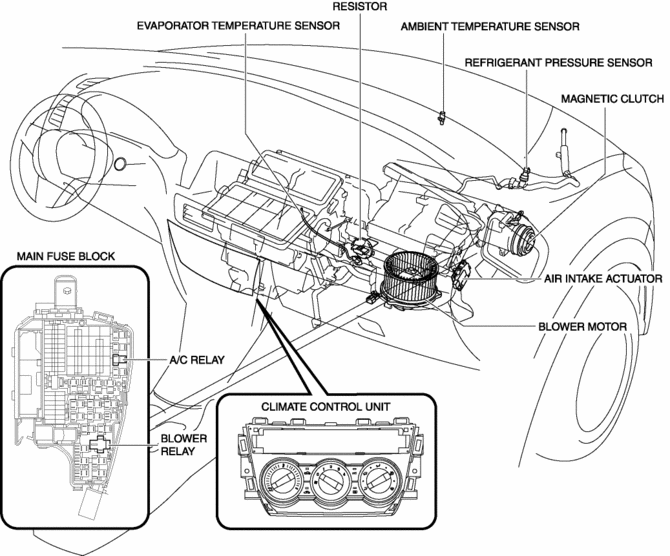Position:Home » Industry News
Heater Blower Motor Resistor in Air Conditioner
Writer:Microhm Page View:Date:2019-09-03
Resistors, as main passive components are widely used in all applications required electricity, including air conditioner. The heater blower motor reduces or increases the amount of air blowing through the dashboard vents based on the fan speed selected or, in an automatic climate control system, the interior temperature and other factors. But resistors, small electronic parts tucked out of sight, are what actually control the fan speed by reducing the amount of electrical current going to the blower motor.
When everything is working properly, setting the fan speed at its lowest setting, for example, will tell the resistor to restrict the amount of current to a low level. But if the resistor burns out or wears out from corrosion, there is nothing to reduce the amount of voltage going to the blower motor for the lowest fan speed, so it will most likely get the maximum current and run at full speed.

When a resistor fails, the fan will often run only at higher speeds or the highest speed, no matter what fan speed is selected. In some vehicles, though, the fan may not work at all, and only a little may come through the vents.
On many vehicles, the blower motor resistor, which comes as a module that connects to an electrical wire and is mounted near the blower motor, is accessible by removing the glove box or checking under the dashboard. On others it’s behind the dashboard, and part of the dashboard may have to be disassembled to reach it.
If little air is coming through the vents (hot or cold), then it could be because the blower motor for the fan or a switch or resistor that controls fan speed isn’t working. Another cause might be that the electronically controlled “blend doors” that direct air flow are stuck or broken.

When a blower resistor fails, the highest fan speed usually is the only one that still works because it essentially bypasses the resistor and receives the maximum amount of voltage. When the resistor is working, it reduces the amount of voltage going to the lower fan speeds so the fan runs slower.
Blower resistors are small parts that can become corroded or just burn out, and a new one often costs less than $50. Because they’re usually under the dashboard on the passenger’s side or behind the glove box, near the blower motor, they can be hard to reach if they need to be replaced.
Though having only one fan speed usually indicates a bad blower resistor, diligent mechanics will test the resistor, fan switch and connections to the blower motor to make sure before they start replacing parts. If none of the fan speeds work, then checking the fuse or fuses for the heating, vent and air conditioning systems is a logical first step.
When everything is working properly, setting the fan speed at its lowest setting, for example, will tell the resistor to restrict the amount of current to a low level. But if the resistor burns out or wears out from corrosion, there is nothing to reduce the amount of voltage going to the blower motor for the lowest fan speed, so it will most likely get the maximum current and run at full speed.

When a resistor fails, the fan will often run only at higher speeds or the highest speed, no matter what fan speed is selected. In some vehicles, though, the fan may not work at all, and only a little may come through the vents.
On many vehicles, the blower motor resistor, which comes as a module that connects to an electrical wire and is mounted near the blower motor, is accessible by removing the glove box or checking under the dashboard. On others it’s behind the dashboard, and part of the dashboard may have to be disassembled to reach it.
If little air is coming through the vents (hot or cold), then it could be because the blower motor for the fan or a switch or resistor that controls fan speed isn’t working. Another cause might be that the electronically controlled “blend doors” that direct air flow are stuck or broken.

The fan switch may be at fault, but a more likely reason is that a blower motor resistor that controls the voltage going to the blower has packed it in, resulting in only one speed remaining operable – usually the highest speed.
When a blower resistor fails, the highest fan speed usually is the only one that still works because it essentially bypasses the resistor and receives the maximum amount of voltage. When the resistor is working, it reduces the amount of voltage going to the lower fan speeds so the fan runs slower.
Blower resistors are small parts that can become corroded or just burn out, and a new one often costs less than $50. Because they’re usually under the dashboard on the passenger’s side or behind the glove box, near the blower motor, they can be hard to reach if they need to be replaced.
Though having only one fan speed usually indicates a bad blower resistor, diligent mechanics will test the resistor, fan switch and connections to the blower motor to make sure before they start replacing parts. If none of the fan speeds work, then checking the fuse or fuses for the heating, vent and air conditioning systems is a logical first step.
Keywords:Blower Resis
Latest News
- Resistor's role in measuring and correcting LED,,,
- Single through-hole resistors' characteristics ,,,
- Why shunt resistors for current sense applicati,,,
- Metal-film resistors with small size, high resi,,,
- 36W High-Current Shunt Resistors MMS8420,,,
- 1W Surface Mount Resistor MPR1206,,,
- An Overview of Microhm Electronics' Resistor Pr,,,
- More anti-sulfur resistors used in harsh envir,,,
- Resistance changes with temperature,,,
- 140W TO247 High Power Heatsinkable Resistor,,,
- MMS5930 is ideal for current sensing in industr,,,
- Shunt resistors selection for engineers' design,,,
- Considerations for choosing precision resistors,,,
- Ceramic Encased Cement Resistors NWH Series for,,,
- Resistors for Passive Balancing in Battery-Pow,,,
Hot Articles
- Microhm will take part in 10th Automotive World,,,
- Thanks for Visiting Microhm's Booth E5-5706 in ,,,
- Resistors in Short Supply: Blame Cars,,,
- New lunch: High Power Precision Shunt Resistor,,,,
- How to Test a Resistor,,,
- Innovative Technology, Future Electric: Electri,,,
- What is Precision Resistors?,,,
- SMD Resistors Sizes and Packages,,,
- The Construction and Features of Metal Film Res,,,
- What is a TO-220 Resisor?,,,
- Hot Selling Products: Precision Shunt Resistors,,,
- How to Calculate the Equivalent Resistance Valu,,,
- What is a Fixed Resistor?,,,
- Resistors in LED Circuits,,,
- Resistors Types and Materials Overview,,,
Resistance applications
- BMS for New Energy Vehicle,,,
- Select the Right Resistor for Harmonic Filterin,,,
- Shunt Resistor MMS8420 for High Current Stable ,,,
- The Main Application for High Precision and Low,,,
- Heater Blower Motor Resistor in Air Conditioner,,,
- The Measurement Accuracy of Automotive Shunt is,,,
- Industrial Roberts Applied to Solar Photovoltai,,,
- The Four Important Functions of Alloy Resistors,,,
- Surface Mount Resistor's Size and Package ,,,
- Urbanization Development Bringing the Transform,,,
- Why Zero-Ohm Resistors?,,,
- Carbon Film Resistors' Features and Application,,,
- Miniature future for passive electronic compone,,,
- Difference Between High Precision Resistors and,,,
- Precision Resistors' Construction and TCR,,,
